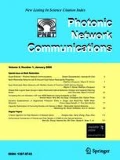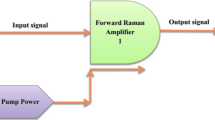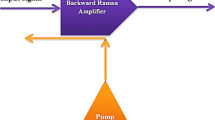Abstract
We analyzed the four wave mixing (FWM) effect by propagating two channels through the same backward pumped fiber Raman amplifier (FRA) with variations in FRA parameters. It is observed that FWM increases with increase in signal input power as well as pump power. The FWM effect is also analyzed for Raman constant \(({f}_{\text{ r }})\) to obtain the optimum value of \(({f}_{\text{ r }})\), and it is found that to have minimum FWM, the optimum value of Raman constant comes out to be 0.18. This Raman amplifier can be used for wavelength division multiplexed application with constant broadband gain.





Similar content being viewed by others
References
Keisser, G.: Optical Fiber Communications, 4th edn, p. 429. Tata McGraw-Hill Publications, New Delhi (2008)
Toulouse, J.: Optical nonlinearities in fibers: review, recent examples, and systems applications. IEEE J. Lightwave Technol. 23, 3625–3641 (2005)
Wu, M., Way, W.I.: Fiber nonlinearity limitations in ultra-dense WDM systems. IEEE J. Lightwave Technol. 22, 1483–1498 (2004)
Agarwal, G.P.: Nonlinear Fiber Optics, 4th edn. Academic Press, San Diego, CA (2006)
Forghieri, F., Tkach, R.W., Chraplyvy, A.R.: Fiber nonlinearities and their impact on transmission systems. In: Kaminow, I.P., Koch, T.L. (eds.) Optical Fiber Telecommunications-III, vol. A. Academic Press, New York (1997)
Shibata, N., Barun, R.P., Waarts, R.G.: Phase-match dependence of efficiency of wave generation through four wave mixing in a single-mode fiber. IEEE J. Quantum Electron. 23, 1205–1210 (1987)
Tkach, R.W., Chraplyvy, A.R., Forghieri, F., Gnauck, A.H., Dorosier, R.M.: Four-photon mixing and high-speed WDM systems. IEEE J. Lightwave Technol. 13, 841–849 (1995)
Zeiler, W., Di Pasquale, F., Bayvel, P., Midwinter, J.E.: Modeling of four-wave mixing and gain peaking in amplified WDM optical communication systems and networks. IEEE J. Lightwave Technol. 14, 1933–1941 (1996)
Keisser, G.: Optical Fiber Communications, 4th edn, p. 437. Tata McGraw-Hill Publications, New Delhi (2008)
Agarwal, G.P.: Fiber-Optic Communication Systems, 3rd edn, p. 372. John Wiley and Sons, New York (2002)
Mynbaev, D.K., Scheiner, L.L.: Fiber-Optic Communication Technology, 3rd edn, p. 223. Pearson Education Publications, New Delhi (2007)
Author information
Authors and Affiliations
Corresponding author
Rights and permissions
About this article
Cite this article
Bindal, A., Singh, S. Optimization of fiber Raman amplifier by reduction of four wave mixing effect. Photon Netw Commun 28, 214–217 (2014). https://doi.org/10.1007/s11107-014-0447-1
Received:
Accepted:
Published:
Issue Date:
DOI: https://doi.org/10.1007/s11107-014-0447-1




